Buyer’s Guide: Antique Tea, Card & Games Tables
Antique tea, card, and games tables offer more than eye-catching proportions; they reveal the social customs and inventive design of the Georgian, Victorian and Edwardian eras. Whether designed for quiet afternoon tea or lively evening play, these tables combine form and function with remarkable creativity.
Most antique card tables feature baize-lined playing surfaces and discreet drawers for counters or cards. Games tables often have inlaid tops for chess or backgammon, while tea tables showcase polished wood surfaces with fine veneers or delicate mouldings.
This guide explores the key types, materials and features to look for, and how to identify the most desirable and authentic pieces for your home or collection.
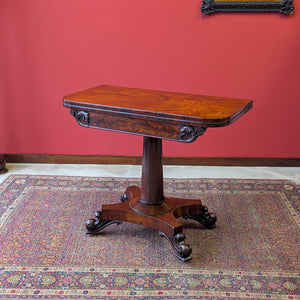
Key Differences Between Tea Tables, Card Tables & Games Tables
Though frequently sharing similar forms, and therefore commonly grouped together, tea tables, card tables and games tables were designed for distinct purposes and each have their own defining characteristics. Knowing the differences can help you recognise the right piece for your home.
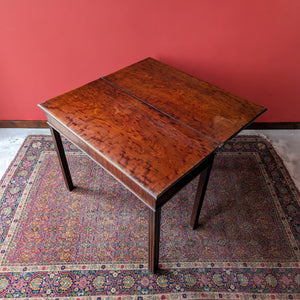
Antique Tea Tables
Intended to serve light refreshments during sociable moments at home, tea tables regularly feature fold-over tops, allowing them to be moved to a more central location when needed and opened to provide significantly more surface area.
Unlike card or games tables, their tops are not typically lined; instead, they showcase polished wood surfaces, often in mahogany, walnut, satinwood or rosewood.
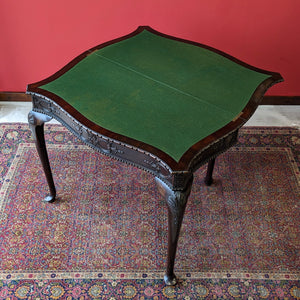
Antique Card Tables
Card tables on the other hand, were purpose-built for gaming, especially whist or similar card games popular from the Georgian period onwards. They remained popular in the Victorian and Edwardian periods, where they commonly formed part of a broader suite of parlour or drawing room furniture.
Most examples have fold-over tops, which open to reveal a baize-lined playing surface within. They sometimes feature shallow drawers, typically hidden or discreetly integrated, for holding counters or cards. Pedestal and gateleg bases are equally common, with proportions suited to four players seated comfortably.
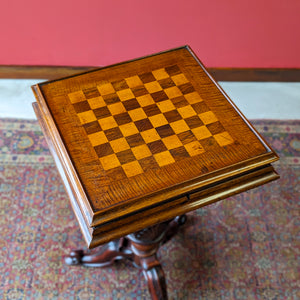
Antique Games Tables
Games tables occasionally overlap somewhat with card tables, but the term generally refers to tops inlaid with some kind of other specific gaming surface beyond cards, such as inlaid chess or backgammon boards.
These were in many cases made as statement pieces for the parlour or drawing room, combining decorative appeal with a clear social function.
Common Tea, Games & Card Table Mechanisms
Many antique tea, card and games tables were designed with clever mechanisms that allowed them to serve multiple functions or reduce their footprint when not in use. Fold-over tops are by far the most common feature across card and tea tables. Typically, the top is hinged and one leaf folds open, doubling the surface area of the table.
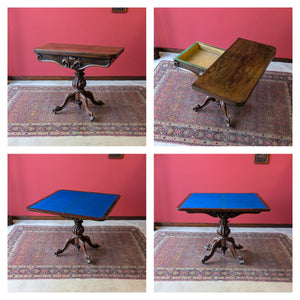
Swivel Top Card & Tea Tables
On many tables of this kind, the upper section swivels before unfolding, allowing the opened leaf to rest on the revealed section of the base.
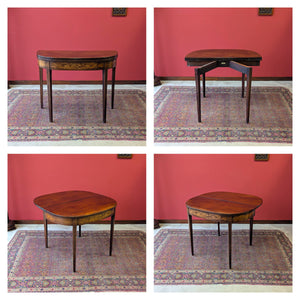
Gateleg Card & Tea Tables
In other examples, gatelegs, normally integrated into the frame, are moved into position to support the top leaf when folded open.
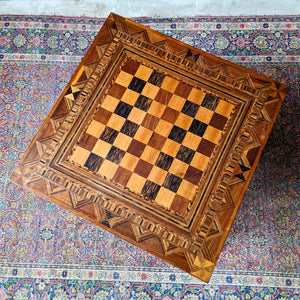
Games Tables
Most games tables include inlaid playing surfaces like chess or backgammon boards set directly into the wood, normally requiring no conversion.
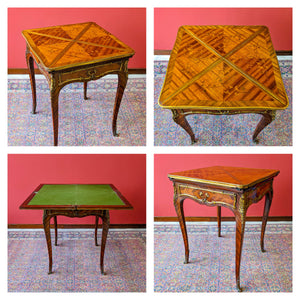
Envelope Card Tables
Envelope card tables feature a top that swivels, then folds outwards like envelope flaps, revealing a baize-lined playing surface inside.
Tea, Games & Card Tables by Period: Georgian, Regency, Victorian or Edwardian?
Understanding the subtle differences between Georgian, Regency, Victorian and Edwardian tea, games and card tables is essential for recognising authenticity and appreciating their evolving styles and functions.
Each period reflects distinct tastes, materials and craftsmanship that influenced design and shaped the social rituals surrounding leisure and entertainment. This section explores key characteristics of these tables from each era, helping you identify and select pieces that best suit your lifestyle.
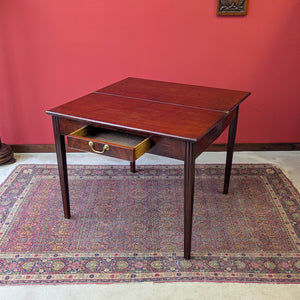
Georgian Tea, Games & Card Tables (1714–1830)
Georgian tables in this category reflect the refinement and restraint typical of the early 18th to early 19th centuries. These pieces often feature simple, classical forms with clean lines and balanced proportions, crafted primarily in mahogany.
Tea tables of this period were usually straightforward in design, intended for serving refreshments during intimate domestic gatherings. Card tables began to gain popularity as the game of whist became fashionable, with early examples incorporating basic fold-over tops and gateleg supports. Baize linings were less common in Georgian card tables, but the emphasis on refined craftsmanship and classical detailing remained paramount.
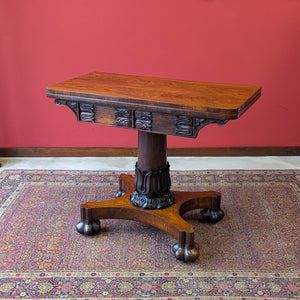
Regency Tea, Games & Card Tables (1811–1820)
The Regency era introduced a new level of decorative richness and sophistication to tea, card and games tables. This period saw the increased use of exotic veneers such as rosewood and satinwood.
Card tables from the Regency period began to feature baize-lined playing surfaces and swivel tops began to appear, reflecting the popularity of gaming during this time. Legs became more slender and stylised, commonly saber-shaped or turned, contributing to a lighter, more delicate aesthetic. These tables were designed not only for function but also to impress as decorative focal points in fashionable drawing rooms.
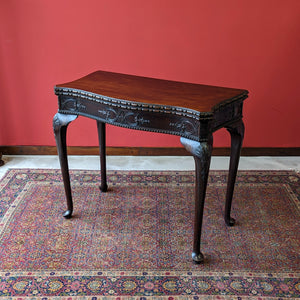
Victorian Tea, Games & Card Tables (1837–1901)
Victorian tea, card, and games tables are notable for their ornate decoration and multifunctional design. The expanding middle class’s appetite for parlour entertainment drove the creation of tables featuring intricate inlays, carving and ornamentation.
Baize linings became standard on card tables, which now more frequently included fold-over tops with swivel mechanisms for ease of use. Bases varied greatly during this period, with a mix of pedestals and standard gateleg styles, offering both stability and visual presence. These tables served as essential pieces in parlours and drawing rooms, facilitating a variety of social games and reflecting the era’s taste for richness and complexity.
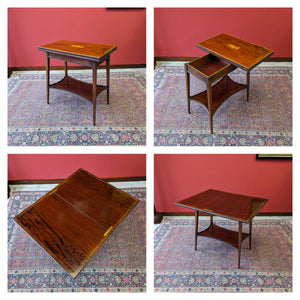
Edwardian Tea, Games & Card Tables (1901–1910)
Edwardian tables mark a shift toward lighter, more delicate constructions that balanced beauty with practicality. Satinwood and polished veneers and inlays remained popular, but the decoration became more restrained compared to the Victorian period.
Tea, card, and games tables of this era often featured cleaner lines, aligning with changing social habits and the move toward less formal entertaining. Despite their lighter appearance, these tables maintained multifunctional use, designed to fit comfortably in smaller rooms while retaining an air of sophistication suited to Edwardian tastes.
Decorative vs. Functional Use Today
Many tea, card and games tables remain perfectly functional today and are still remain suited to their intended use. Fold-over or swivel tops provide a flexible surface area for serving refreshments, playing games or working on small projects. Baize-lined card and games tables continue to offer authentic spaces for social card playing or board games.
In some modern homes these tables frequently serve as purely side tables in their closed positions, rarely being bought out and extended. This is because as closed tables they provide excellent focal points in living rooms, studies or halls. Their fine veneers, intricate inlays and historic character add depth and sophistication to any interior.
When integrating these tables into modern living, consider scale and placement carefully. Smaller rooms or apartments may benefit from a compact tea or card table that doubles as a side or console table. Conversely, larger homes can accommodate games tables as dedicated social or conversation pieces.
Ultimately, whether prized for their beauty, their utility or both, these tables invite owners to enjoy a tangible connection to history while enhancing contemporary living.
Antique Tea, Games & Card Table FAQs
What defines an antique tea table?
A small table designed for serving tea, often with a fold-over top and polished wood surface.
What defines an antique card table?
A table designed primarily for playing card games, typically featuring a fold-over top with a baize-lined playing surface.
What is a fold-over top?
A hinged table top that folds back to double the surface area, very common in card and tea tables.
Are baize linings original or replaced?
Many tables retain their original baize, but replacements are common due to wear. We preserve originals where possible but replace them when necessary.
Can antique games tables be used today?
Yes, many remain functional and offer an excellent authentic play surface for card games or board games.
What is the difference between a tea table and a card table?
Tea tables normally have fixed or fold-over tops with all polished surfaces, designed primarily for serving and entertaining; card tables usually have fold-over tops with baize linings, specifically intended for gaming.
How do I care for baize-lined tables?
Keep dry and avoid spills mainly. Other than that, use a soft brush to clean them and keep them tidy.
Are tea tables suitable for small homes?
Yes, their compact size and multifunctional design particularly suit smaller living spaces.
Can card tables complement modern decor?
Yes, their timeless design adds character to both classic and contemporary interiors.
These tables aren’t just antiques; they’re conversation starters and reliable companions for every social occasion. From quiet afternoons to lively game nights, our collection blends authentic craftsmanship with everyday charm.
See something that sparks your interest? Order securely online with UK delivery included. Prefer a friendly chat before deciding? Reach out anytime, we love talking about the finer details.
















